Article
Use of robotics in pediatric urology
This article examines the relative benefits of robotic surgery in children and special considerations in this patient population, then describes some robotic cases commonly performed for pediatric urologic conditions today.


The application of robotic surgery to children, like laparoscopy, evolved after a considerable experience in adult urology. The first reports of robotic cases in children arrived in 2002 when there were few pediatric urologists performing robotic surgery. Today, robotic surgery has a firm hold in nearly every pediatric urology fellowship training program. (We have four surgeons performing robotic surgery and three others who are currently training to do so.) Robot-assisted surgery in adults has been widespread and applied primarily for high-volume oncologic cases (eg, prostatectomy). In children, robotic surgery is applied to problems with lower prevalence and more so for reconstruction (pyeloplasty, ureteral reimplantation, augmentation cystoplasty, appendicovesicostomy), although extirpative surgeries (nephrectomy, heminephrectomy, and excision of Müllerian structures) have also been performed.
This article examines the relative benefits of robotic surgery in children and special considerations in this patient population, then describes some robotic cases commonly performed for pediatric urologic conditions today.
Instrumentation
The da Vinci Surgical System (Intuitive Surgical, Inc., Sunnyvale, CA) is the most popular system in the U.S. Each generation of the robotic system improves its optics, mechanics, and size. The fundamental mechanics of robotic surgery consist of the surgeon sitting at a separate console (not necessarily in the same room) and controlling the movement of the surgical robotic arms positioned intracorporeally, using the thumb and forefinger placed in the master grips. While four arms are available on the current da Vinci S unit, three arms are typically used for pediatric urologic cases. Each arm carries instruments with seven degrees of freedom. The surgeon’s natural tremor is reduced electronically and the 3-D view of the operative field at the console is magnified 10 times.
Continue to the next page for more.
Benefits
The debate surrounding robotic surgery in children has centered on comparing its benefits to open surgery and laparoscopic surgery and, of course, its cost. In summary, robotic surgery offers the dexterity, precision, and success rates offered by open surgery but with better cosmesis, which is important to parents (J Urol 2013; 190:244-50), along with the lower pain and faster recuperation associated with laparoscopic surgery. The robot offers superior eye-hand coordination, instrument positioning, and suturing ability when compared to laparoscopic surgery. Unfortunately, in pediatric urology, the learning curve is slowed by the absence of a high-volume case load (eg, prostatectomy, hysterectomy), which hinders its widespread acceptance. For pediatric urologists who perform extravesical ureteral reimplantation and pyeloplasties through extremely small incisions (J Pediatr Urol 2011; 7:257-60) and on an outpatient basis (J Urol 2008; 180[4 suppl]:1828-31), the benefits of a robotic approach are arguable.
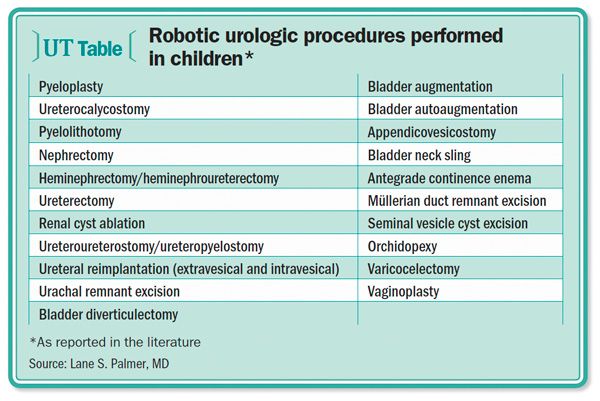
The associated cost of owning and maintaining a robotic operative system as well as the costs of longer surgical times will make robotic surgery more expensive than analogous open or laparoscopic surgery.
Considerations for robotic surgery in children
Access. There is a greater potential for injury to the intra-abdominal organs during access in children than in adults because of the smaller anterior-posterior space. To mitigate against injury, an open technique for gaining initial access for the camera port is safest. In this technique, the skin and rectus fascia as well as the peritoneum are opened and the trocar inserted directly into the abdomen. Subsequent ports can then be placed percutaneously under direct vision.
Insufflation. The physiologic differences between children and adults are clearly beyond the scope of this article. However, suffice it to say that the increases in systemic and pulmonary vascular resistance, decrease in cardiac output, limitations in pulmonary excursion, etc. can be managed effectively by maintaining low insufflation pressures (8-12 mmHg) throughout the case.
Port placement. Similarly, children have smaller spaces on their abdomen for placement of ports. However, ports need to be spaced far enough apart to avoid limiting the range of motion or clashing of the robot arms. For example, port placement for children differs from adults undergoing pyeloplasty in that the lateral port is placed more obliquely, into the lower quadrant, rather than at near right angles. This issue is less problematic with the use of smaller trocars.
Instrumentation. Pediatric urologists are conditioned to using small and fine instruments and suture. There has been great progress in developing smaller scopes and instruments to meet these needs. The camera port is 8.5F while the working ports are 5F and 8F, which accommodate the various graspers, dissectors, forceps, and scissors that are currently available. Both bipolar and monopolar electrocautery are available.
Port closure. We routinely close 5-mm ports in children. Proportionately, this size fascial defect poses a higher risk of incarceration of mesentery or bowel than in adults.
Continue to the next page for more.
Common procedures
Robotic surgery has been applied to many pediatric urologic patients and conditions, as listed in the table. The need to employ the robot for some of these cases is debatable, as a laparoscopic approach may offer similar benefits (eg, in orchidopexy, varicocelectomy). The more common robotic cases will be discussed below.
Pyeloplasty. This is the most common procedure performed robotically in children. The child is placed in the modified flank position and secured to the table after padding all pressure points. The table can be rolled to facilitate exposure. Port placement (8.5-mm camera port and either two 5-mm or one 5-mm and one 8-mm port) is noted in figure 1.
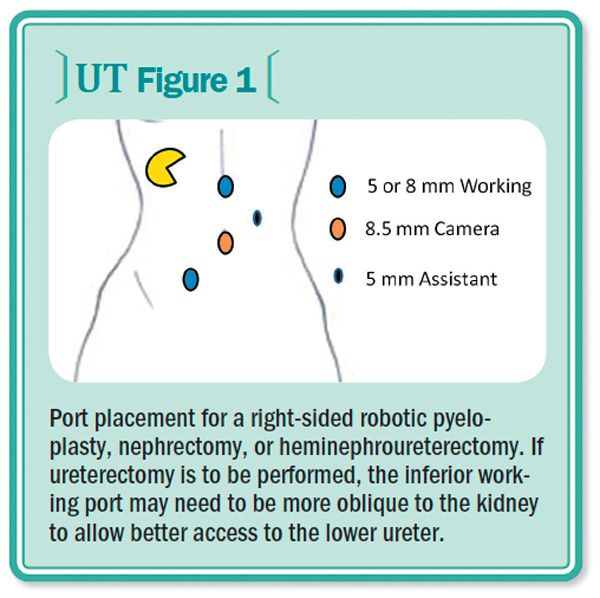
The pertinent surgical steps include bowel mobilization along the line of Toldt, duodenal mobilization for right-sided ureteropelvic junction (UPJ) obstruction, identification of the ureter lateral to the gonadal vessels or just off the lower pole of the kidney or traced distally from the pelvis (preoperative placement of the double-J stent or open-ended catheter can facilitate its identification), identification of possible crossing vessels to the lower pole, UPJ division for transposition anterior to crossing vessels or resection of a stenotic segment, spatulation of the ureter, and anastomosis in either running or interrupted fashion. Stenting the anastomosis can be performed cystoscopically prior to incision or antegrade through either a 14-gauge angiocatheter (accommodates 4.7F) or the assistant’s port (larger stents). When the obstruction is on the left and the pelvis is very large, a transmesenteric approach to the UPJ is very efficient. In short obstructions in the absence of a crossing vessel, a Fenger type Y-V plasty may be considered (figure 2).
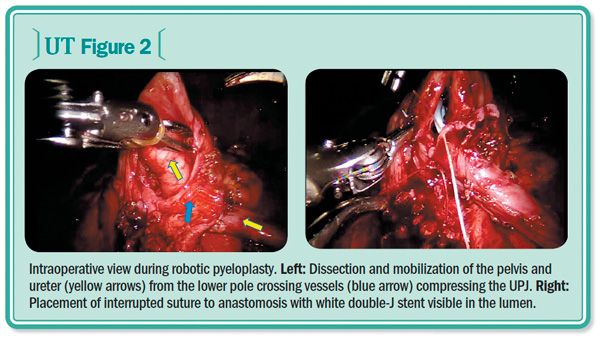
Continue to the next page for more.
Several published reports compare open to robotic pyeloplasty as well as longer-term follow-up. Collectively, the reported success rates are similar; the length of stay and narcotic needs were lower or similar to those of open pyeloplasty. Operative times continue to be longer for the robotic pyeloplasty, but several studies report improvement with experience. In a longer-term report (2002-2009) on 155 cases, the group from Children’s Hospital Boston reported stable success and complication rates but significantly decreased mean operative time and length of hospitalization by the end of the study (J Urol 2011; 185:1455-60).
Heminephrectomy. In contrast to adults where heminephrectomy is typically performed for malignancy, in children, heminephrectomy or heminephroureterectomy is performed in the setting of a duplicated system with severely compromised function of the upper pole moiety from ureterovesical junction obstruction (ureterocele, ectopic insertion). Patient positioning and port placement mimics that used for pyeloplasty. Stent placement can be considered to identify and thus protect the normal lower pole ureter, which may be dwarfed by the upper pole megaureter and inadvertently injured during separation of the ureters.
The pertinent surgical steps include bowel mobilization along the line of Toldt, duodenal mobilization for right-sided UPJ obstruction, identification of the ureter and the main renal vessels, identification and division of the upper pole vessels superior to the main hilum (figure 3), transection of the upper pole ureter and its mobilization under the hilum, amputation of the upper pole moiety with care to avoid injury to the lower pole parenchyma and collecting system, and finally mobilization of the ureter distally and its amputation at the bladder or more proximally.
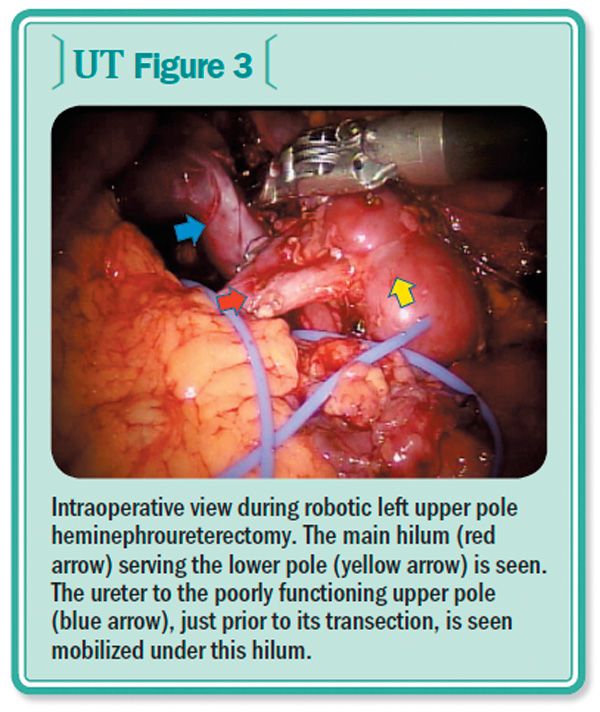
Continue to the next page for more.
Ureteral reimplantation. The extravesical approach is the currently preferred technique and will be described. However, others espouse an intravesical approach, which, in general, is more challenging and less successful than the extravesical approach. The child is placed supine and in Trendelenburg with the legs open or in stirrups. Port placement (one 8.5-mm and two 5-mm ports) is noted in figure 4. A Foley catheter allows selective distension and emptying of the bladder, which facilitates the dissection.
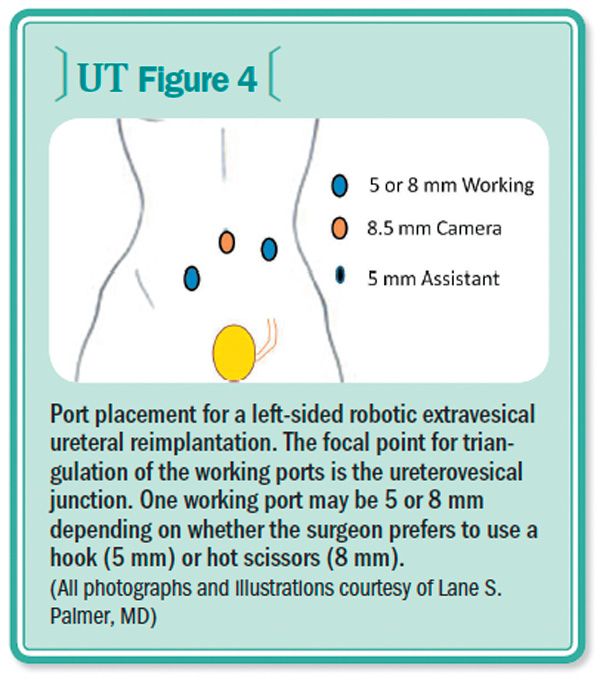
Surgical steps include opening the peritoneal reflection over the bladder caudad to the vas or uterine ligament, mobilization of the ureter, incision of the detrusor muscle down to the mucosa, development of detrusor flaps creating a 4:1 tunnel:ureter ratio, placement of the ureter into the trough, and flap closure. Placement of a stitch into the bladder muscle distal to the ureter and brought out through the skin offers traction and elevation of the bladder, which may facilitate the subsequent steps of the operation. Securing the ureter in the trough prevents persistent reflux and can be achieved by circumferential mobilization of the orifice and an advancement suture or a Y-V plasty distally and inclusion of ureteral adventitia with each suture used for flap closure.
Other applications. The superb access and visualization of the pelvis offered by the robotic approach makes excision of Müllerian remnants, seminal vesicle cysts, and urachal anomalies with partial cystectomy quite easier than either open or laparoscopic approaches. While experience with bladder augmentation is limited because of the complexity of the case, it offers a significant benefit over the traditional approach requiring a large midline incision and long recuperation. In contrast, construction of appendicovesicostomy and antegrade continence enemas without other reconstruction is gaining ground as the robotic approach is quick and considerably less invasive.
Conclusion
We currently practice in an era where a minimally invasive approach to pediatric urologic conditions is a reality. Endoscopy, extracorporeal shock wave lithotripsy, and laparoscopy all have primary roles in managing many urologic conditions in children. The same is becoming true for use of robot-assisted surgery, as it appears to have considerable advantages over laparoscopic and open approaches when applied judiciously. Perhaps, as experience grows and if costs can be contained, we may at some point look back at certain pediatric procedures with historical interest, as we do with anatrophic pyelolothotomy and ureterolithotomy.UT
Subscribe to Urology Times to get monthly news from the leading news source for urologists.

















